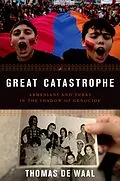The destruction of the Armenians of the Ottoman Empire in 1915-16 was the greatest atrocity of World War I. Around one million Armenians were killed, and the survivors were scattered across the world. Although it is now a century old, the issue of what most of the world calls the Armenian Genocide of 1915 is still a live and divisive issue that mobilizes Armenians across the world, shapes the identity and politics of modern Turkey, and has consumed the attention of U.S. politicians for years. In Great Catastrophe, the eminent scholar and reporter Thomas de Waal looks at the aftermath and politics of the Armenian Genocide and tells the story of recent efforts by courageous Armenians, Kurds, and Turks to come to terms with the disaster as Turkey enters a new post-Kemalist era. The story of what happened to the Armenians in 1915-16 is well-known. Here we are told the "history of the history" and the lesser-known story of what happened to Armenians, Kurds, and Turks in the century that followed. De Waal relates how different generations tackled the issue of the "Great Catastrophe" from the 1920s until the failure of the Protocols signed by independent Armenia and Turkey in 2010. Quarrels between diaspora Armenians supporting and opposing the Soviet Union broke into violence and culminated with the murder of an archbishop in 1933. The devising of the word "genocide," the growth of modern identity politics, and the 50th anniversary of the massacres re-energized a new generation of Armenians. In Turkey the issue was initially forgotten, only to return to the political agenda in the context of the Cold War and an outbreak of Armenian terrorism. More recently, Turkey has started to confront its taboos. In an astonishing revival of oral history, the descendants of tens of thousands of "Islamized Armenians," who have been in the shadows since 1915, have begun to reemerge and reclaim their identities. Drawing on archival sources, reportage and moving personal stories, de Waal tells the full story of Armenian-Turkish relations since the Genocide in all its extraordinary twists and turns. He looks behind the propaganda to examine the realities of a terrible historical crime and the divisive "politics of genocide" it produced. The book throws light not only on our understanding of Armenian-Turkish relations but also of how mass atrocities and historical tragedies shape contemporary politics.
Autorentext
Thomas de Waal is a writer and scholar on the Caucasus and Black Sea region and currently Senior Associate at the Carnegie Endowment for International Peace. He is the author of three books, including The Caucasus: An Introduction. Previously, de Waal worked as a newspaper and radio journalist in London and Moscow.
Inhalt
DEDICATION AUTHOR'S NOTE MAP 1: THE OTTOMAN EMPIRE IN 1914; MAP 2: TURKEY IN 2014 INTRODUCTION: REQUIEM IN DIYARBAKIR CHAPTER 1: THE CATASTROPHE CHAPTER 2: THE HISTORY CHAPTER 3: FROM VAN TO LAUSANNE CHAPTER 4: ASPECTS OF FORGETTING CHAPTER 5: POST-WAR POLITICS CHAPTER 6: AWAKENING CHAPTER 7: ASSAILING TURKEY CHAPTER 8: A TURKISH THAW CHAPTER 9: INDEPENDENT ARMENIA CHAPTER 10: THE PROTOCOLS CHAPTER 11: HIDDEN HISTORIES IN DIYARBAKIR CHAPTER 12: TWO MEMORIALS IN ISTANBUL ENDNOTES
